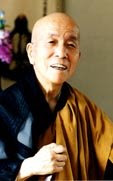Dear Nishijima Sama:
I fear that there are as many Sects of Buddhism as there are leaves on a small tree, but in your years, have you read the Mahavairocana Sutra? (Dainichi-kyo)
(Dear Charles San)
(Thank you very much for your questions, but as you know, I have studied Buddhism relying upon Master Dogen's Buddhist thoughts solely, and so I do not have sufficient experience to read Mahavairocana Sutra, or Dainichi-kyo.)
My limited understanding of the sanskrit 'Maha-vairo-cana' is "Great First Sound." Is that the also the approximate Englich translation of Dainichi-kyo?
(I think that the Vedic Culture belongs to idealistic phylosophy, and even the early Buddhism belongs to realistic philosophy, and so it is impossible for me to identify the Vedic Culture with the early Buddhist Sangha.)
To what degree do you think the Vedic Culture might have influenced the early Buddhist Sangha?
(I think that the vedic Culture is an idealistic philosophy. but even the early Buddhist Sangha
belongs Realistic philosophy, and so it is impossible for me to identify the vedic Culture and
the early Buddhist Sangha together at all.)
Do you know that the Soto Zen Text Project at Stanford University is also translating Dogen's Autograph Shobogenzu into English?
(I heard that the Soto Zen Text Project at Stanford University has been translating Dogen's Autograph Shobogenzo, but I haven't had a chance to read it yet.)
I know that 'cognitive equivalence' between languages is a concern and that a single passage in Archaic Japanese may take 3 or 4 weeks to translate because of the differences between an old concept and the same concept in Modern Japanese.
(I think that even Japanese, which Master Dogen used in writing Shobogenzo 13th Century, was so much different from the modern Japanese, and so even though I am a native speaker of Japanese,
it was necessary for me to spend 16 years to translate Shobogenzo 98 Chapters from the old Japanese by Master Dogen into the modern Japanese today utilizing 8 hours everyday throughout
365, or 366 days every year.)
Did you see the Haiku?
(I have read your Haiku now.)
In 1986 I co-wrote this with my wife to illustrate to our technical translation department that some Japanese could not be translated without having the mind of the writer.
It is not so easy to translate Japanese into English in this case.
(It is true, and so I have to use about 8 hours everyday for 16 years to translate Master Dogen's Shobogenzo in Medieval Ages into Japanese Modern Words, and I needed more 6 years to translate Shobogenzo in Modern Japanese into English, before I pass my own draft to rewriters Mr Jeffery Bailey and Mr Mice Cross.)
Compared to Zazen, what is your advice on standing meditation, walking meditation, and meditation in repose?
(I think that standing and walking are much more getting tired, and meditation in repose doesn't work at all.)
I no longer sit Zazen (2 years now) due to hip pain. Sitting meditation for me is sitting in a firm chair.
(Unfortunately without Zazen there is no Buddhism at all.)
[THWAK!!!]
[In gratitude for this lesson, I bow deeply and go away.]
domo arigato gozaimashita sensei,
Charles
(O-cha-ryu)
Thank you very much for your sincere questions.
Gudo Wafu Nishijima



0 Comments:
Post a Comment
<< Home